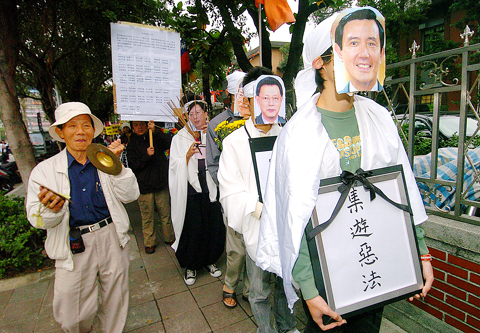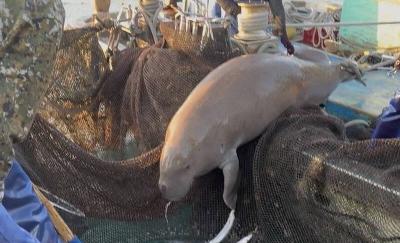Chinese Nationalist Party (KMT) and Democratic Progressive Party (DPP) lawmakers waged a war of words yesterday as they accused each other of slowing down or blocking the Assembly and Parade Law (集會遊行法) revision process.
The legislature’s Internal Administration Committee had been scheduled to review draft amendments submitted by both parties yesterday.
However, DPP caucus whip William Lai (賴清德) protested when KMT Legislator Wu Yu-sheng (吳育昇), the committee’s convener, said the legislature should wait for the Cabinet to propose its own draft amendment and hold a public hearing next Thursday.

PHOTO: CHIEN JUNG-FONG, TAIPEI TIMES
“You’re trying to delay the [law revision] process by holding yet another public hearing next week,” Lai said.
“We should start an article-by-article review after a general discussion today,” he said.
Wu disagreed, saying that the goal of a public hearing was “to hear opinions from different people, including the Wild Strawberries,” in a bid to improve the quality of the amendment.
The “Wild Strawberry Movement” refers to a group of college students staging a silent sit-in protest at Liberty Square in Taipei since Nov. 6. Their demands include revision of the law.
“If the DPP is opposed to a public hearing, then you should go out and tell the Wild Strawberries,” Wu said.
The dispute intensified when DPP lawmakers accused the KMT of having a long history of blocking revisions to the law.
“During a meeting in 2006 over which you, Wu Yu-sheng, presided, you tried to block the Assembly and Parade Law amendment process,” Lai said.
“I’ve always respected you, Legislator Lai, but as a politician, you should not lie,” Wu shouted back.
“Yes, there was a public hearing in 2006, and yes, I presided over the meeting — but it was the DPP that opposed an article-by-article review [of the Assembly and Parade Law] afterwards,” Wu said.
Several DPP and KMT lawmakers joined their colleagues in the debate, but the two sides failed to reach a consensus, leaving the Assembly and Parade Law amendment process stalled.
Later, a few KMT legislators including Wang Jin-shih (王進士) expressed concern that revising the Assembly and Parade Law might result in too many protests.
If the requirement for event organizers to seek approval from law enforcement authorities before holding a rally is rescinded, “then there may be demonstrations every day, which could lead to social unrest,” Wang said.
“As long as people don’t open their minds, and bear hatred in their minds, they will take it to the street every day,” Wang added.

The High Prosecutors’ Office yesterday withdrew an appeal against the acquittal of a former bank manager 22 years after his death, marking Taiwan’s first instance of prosecutors rendering posthumous justice to a wrongfully convicted defendant. Chu Ching-en (諸慶恩) — formerly a manager at the Taipei branch of BNP Paribas — was in 1999 accused by Weng Mao-chung (翁茂鍾), then-president of Chia Her Industrial Co, of forging a request for a fixed deposit of US$10 million by I-Hwa Industrial Co, a subsidiary of Chia Her, which was used as collateral. Chu was ruled not guilty in the first trial, but was found guilty

‘DENIAL DEFENSE’: The US would increase its military presence with uncrewed ships, and submarines, while boosting defense in the Indo-Pacific, a Pete Hegseth memo said The US is reorienting its military strategy to focus primarily on deterring a potential Chinese invasion of Taiwan, a memo signed by US Secretary of Defense Pete Hegseth showed. The memo also called on Taiwan to increase its defense spending. The document, known as the “Interim National Defense Strategic Guidance,” was distributed this month and detailed the national defense plans of US President Donald Trump’s administration, an article in the Washington Post said on Saturday. It outlines how the US can prepare for a potential war with China and defend itself from threats in the “near abroad,” including Greenland and the Panama

DEADLOCK: As the commission is unable to forum a quorum to review license renewal applications, the channel operators are not at fault and can air past their license date The National Communications Commission (NCC) yesterday said that the Public Television Service (PTS) and 36 other television and radio broadcasters could continue airing, despite the commission’s inability to meet a quorum to review their license renewal applications. The licenses of PTS and the other channels are set to expire between this month and June. The National Communications Commission Organization Act (國家通訊傳播委員會組織法) stipulates that the commission must meet the mandated quorum of four to hold a valid meeting. The seven-member commission currently has only three commissioners. “We have informed the channel operators of the progress we have made in reviewing their license renewal applications, and

A wild live dugong was found in Taiwan for the first time in 88 years, after it was accidentally caught by a fisher’s net on Tuesday in Yilan County’s Fenniaolin (粉鳥林). This is the first sighting of the species in Taiwan since 1937, having already been considered “extinct” in the country and considered as “vulnerable” by the International Union for Conservation of Nature. A fisher surnamed Chen (陳) went to Fenniaolin to collect the fish in his netting, but instead caught a 3m long, 500kg dugong. The fisher released the animal back into the wild, not realizing it was an endangered species at